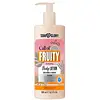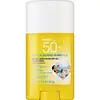What's inside
What's inside
 Key Ingredients
Key Ingredients

 Benefits
Benefits

 Concerns
Concerns

 Ingredients Side-by-side
Ingredients Side-by-side

Water
Skin ConditioningGlycerin
HumectantButyrospermum Parkii Butter
Skin ConditioningDimethicone
EmollientCetearyl Alcohol
EmollientPrunus Amygdalus Dulcis Oil
Skin ConditioningGlyceryl Stearate
EmollientCocos Nucifera Oil
MaskingTheobroma Cacao Seed Butter
EmollientPEG-100 Stearate
Parfum
MaskingDipropylene Glycol
HumectantPhenoxyethanol
PreservativeRosa Canina Fruit Oil
EmollientMangifera Indica Seed Butter
Skin ConditioningCarbomer
Emulsion StabilisingCaprylyl Glycol
EmollientXanthan Gum
EmulsifyingEthylhexylglycerin
Skin ConditioningBenzophenone-4
UV AbsorberTocopheryl Acetate
AntioxidantPotassium Hydroxide
BufferingAloe Barbadensis Leaf Juice Powder
Skin ConditioningGlyceryl Acrylate/Acrylic Acid Copolymer
HumectantTetrasodium EDTA
Passiflora Edulis Fruit Extract
Skin ConditioningCarica Papaya Fruit Extract
Skin ConditioningGlucosamine Hcl
Urea
BufferingLaminaria Digitata Extract
Skin ProtectingSaccharomyces Cerevisiae Extract
Skin ConditioningDenatonium Benzoate
MaskingPotassium Sorbate
PreservativeBenzoic Acid
MaskingSorbic Acid
PreservativeCitric Acid
BufferingCI 15985
Cosmetic ColorantCI 14700
Cosmetic ColorantWater, Glycerin, Butyrospermum Parkii Butter, Dimethicone, Cetearyl Alcohol, Prunus Amygdalus Dulcis Oil, Glyceryl Stearate, Cocos Nucifera Oil, Theobroma Cacao Seed Butter, PEG-100 Stearate, Parfum, Dipropylene Glycol, Phenoxyethanol, Rosa Canina Fruit Oil, Mangifera Indica Seed Butter, Carbomer, Caprylyl Glycol, Xanthan Gum, Ethylhexylglycerin, Benzophenone-4, Tocopheryl Acetate, Potassium Hydroxide, Aloe Barbadensis Leaf Juice Powder, Glyceryl Acrylate/Acrylic Acid Copolymer, Tetrasodium EDTA, Passiflora Edulis Fruit Extract, Carica Papaya Fruit Extract, Glucosamine Hcl, Urea, Laminaria Digitata Extract, Saccharomyces Cerevisiae Extract, Denatonium Benzoate, Potassium Sorbate, Benzoic Acid, Sorbic Acid, Citric Acid, CI 15985, CI 14700
Butyl Methoxydibenzoylmethane 3%
UV AbsorberHomosalate 15%
Skin ConditioningEthylhexyl Salicylate 5%
UV AbsorberOctocrylene 10%
UV AbsorberBenzophenone-3 3%
UV AbsorberAdipic Acid/Diglycol Crosspolymer
Beeswax
Emulsion StabilisingBHT
AntioxidantC12-15 Alkyl Benzoate
AntimicrobialCaprylyl Glycol
EmollientDimethicone
EmollientParfum
MaskingNeopentyl Glycol Diethylhexanoate
EmollientNeopentyl Glycol Diisostearate
EmulsifyingOctyldodecyl Neopentanoate
EmollientOzokerite
Emulsion StabilisingParaffin
PerfumingButyl Methoxydibenzoylmethane 3%, Homosalate 15%, Ethylhexyl Salicylate 5%, Octocrylene 10%, Benzophenone-3 3%, Adipic Acid/Diglycol Crosspolymer, Beeswax, BHT, C12-15 Alkyl Benzoate, Caprylyl Glycol, Dimethicone, Parfum, Neopentyl Glycol Diethylhexanoate, Neopentyl Glycol Diisostearate, Octyldodecyl Neopentanoate, Ozokerite, Paraffin
 Reviews
Reviews

Ingredients Explained
These ingredients are found in both products.
Ingredients higher up in an ingredient list are typically present in a larger amount.
Caprylyl Glycol is a humectant and emollient, meaning it attracts and preserves moisture.
It is a common ingredient in many products, especially those designed to hydrate skin. The primary benefits are retaining moisture, skin softening, and promoting a healthy skin barrier.
Though Caprylyl Glycol is an alcohol derived from fatty acids, it is not the kind that can dry out skin.
This ingredient is also used as a preservative to extend the life of products. It has slight antimicrobial properties.
Learn more about Caprylyl GlycolDimethicone is a type of synthetic silicone created from natural materials such as quartz.
What it does:
Dimethicone comes in different viscosities:
Depending on the viscosity, dimethicone has different properties.
Ingredients lists don't always show which type is used, so we recommend reaching out to the brand if you have questions about the viscosity.
This ingredient is unlikely to cause irritation because it does not get absorbed into skin. However, people with silicone allergies should be careful about using this ingredient.
Note: Dimethicone may contribute to pilling. This is because it is not oil or water soluble, so pilling may occur when layered with products. When mixed with heavy oils in a formula, the outcome is also quite greasy.
Learn more about DimethiconeParfum is a catch-all term for an ingredient or more that is used to give a scent to products.
Also called "fragrance", this ingredient can be a blend of hundreds of chemicals or plant oils. This means every product with "fragrance" or "parfum" in the ingredients list is a different mixture.
For instance, Habanolide is a proprietary trade name for a specific aroma chemical. When used as a fragrance ingredient in cosmetics, most aroma chemicals fall under the broad labeling category of “FRAGRANCE” or “PARFUM” according to EU and US regulations.
The term 'parfum' or 'fragrance' is not regulated in many countries. In many cases, it is up to the brand to define this term.
For instance, many brands choose to label themselves as "fragrance-free" because they are not using synthetic fragrances. However, their products may still contain ingredients such as essential oils that are considered a fragrance by INCI standards.
One example is Calendula flower extract. Calendula is an essential oil that still imparts a scent or 'fragrance'.
Depending on the blend, the ingredients in the mixture can cause allergies and sensitivities on the skin. Some ingredients that are known EU allergens include linalool and citronellol.
Parfum can also be used to mask or cover an unpleasant scent.
The bottom line is: not all fragrances/parfum/ingredients are created equally. If you are worried about fragrances, we recommend taking a closer look at an ingredient. And of course, we always recommend speaking with a professional.
Learn more about Parfum